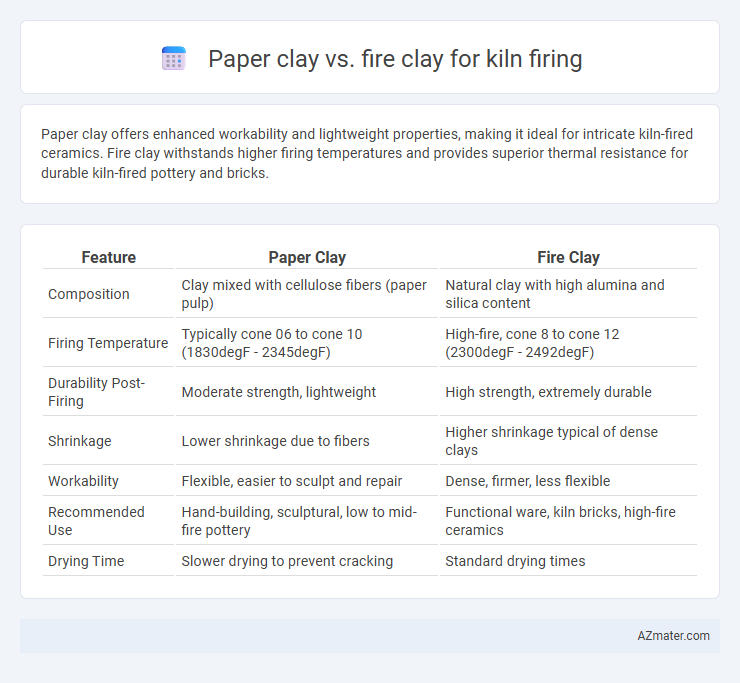Paper clay offers enhanced workability and lightweight properties, making it ideal for intricate kiln-fired ceramics. Fire clay withstands higher firing temperatures and provides superior thermal resistance for durable kiln-fired pottery and bricks.
Table of Comparison
| Feature | Paper Clay | Fire Clay |
|---|---|---|
| Composition | Clay mixed with cellulose fibers (paper pulp) | Natural clay with high alumina and silica content |
| Firing Temperature | Typically cone 06 to cone 10 (1830degF - 2345degF) | High-fire, cone 8 to cone 12 (2300degF - 2492degF) |
| Durability Post-Firing | Moderate strength, lightweight | High strength, extremely durable |
| Shrinkage | Lower shrinkage due to fibers | Higher shrinkage typical of dense clays |
| Workability | Flexible, easier to sculpt and repair | Dense, firmer, less flexible |
| Recommended Use | Hand-building, sculptural, low to mid-fire pottery | Functional ware, kiln bricks, high-fire ceramics |
| Drying Time | Slower drying to prevent cracking | Standard drying times |
Understanding Paper Clay: Composition and Properties
Paper clay, composed of ordinary clay mixed with cellulose fibers such as paper pulp, offers enhanced plasticity and reduced drying shrinkage compared to traditional fire clay, making it ideal for complex kiln-fired ceramics. Its fibrous content allows for improved workability, increased crack resistance during drying, and better joining capabilities, especially in hand-building techniques. Unlike fire clay, which consists mostly of refractory alumina and silica for high-temperature durability, paper clay is more versatile in sculptural applications but requires careful firing schedules to achieve optimal strength and surface finish.
What is Fire Clay? Key Characteristics Explained
Fire clay is a type of refractory clay that withstands high temperatures up to 1700degC (3092degF) without deforming or melting, making it ideal for kiln firing applications. It contains a high amount of alumina and silica, which provide excellent thermal stability, resistance to thermal shock, and durability during repeated firing cycles. Unlike paper clay, fire clay is dense and non-porous, ensuring structural integrity and strength in ceramic and pottery pieces fired in kilns.
Preparing for Kiln Firing: Paper Clay vs Fire Clay
Paper clay offers enhanced flexibility and reduced drying time compared to fire clay, making it easier to prepare and shape before kiln firing. Fire clay requires thorough wedging and careful moisture control to avoid cracking due to its dense, refractory nature. Understanding these preparation differences ensures optimal results during kiln firing, with paper clay accommodating complex forms and fire clay providing superior heat resistance.
Workability and Sculpting Differences
Paper clay contains cellulose fibers that enhance workability by making the clay more flexible and less prone to cracking during sculpting, especially for hand-building and detailed forms. Fire clay, known for its high refractory properties, is denser and stiffer, requiring more skill to manipulate but providing superior strength and durability after kiln firing. The fiber content in paper clay allows for thinner, more intricate sculptures, while fire clay's coarse texture suits robust, heat-resistant pieces ideal for functional ceramics.
Drying Behavior: Which Clay Cracks Less?
Paper clay exhibits superior drying behavior compared to fire clay, as its fiber content improves moisture retention and reduces shrinkage during drying, resulting in fewer cracks. Fire clay, with its dense and fine particle structure, tends to dry faster but is more prone to cracking due to higher shrinkage stresses. Ceramic artists seeking minimal cracking during kiln firing often prefer paper clay for its enhanced drying flexibility and crack resistance.
Firing Temperatures and Kiln Compatibility
Paper clay typically fires at lower temperatures ranging from cone 06 (1828degF or 998degC) to cone 04 (1940degF or 1060degC), making it compatible with electric and small-scale gas kilns. Fire clay, known for its refractory properties, withstands much higher firing temperatures, often up to cone 10 (2345degF or 1285degC), and is suitable for high-temperature gas or wood-fired kilns. Selecting between paper clay and fire clay depends on the desired firing range and the kiln's maximum temperature capability to ensure optimal vitrification and workability.
Strength and Durability After Firing
Fire clay exhibits superior strength and durability after kiln firing due to its high alumina content and resistance to thermal shock, making it ideal for applications requiring structural integrity. Paper clay, while offering enhanced workability and reduced drying cracks before firing, typically results in a more porous and less robust final product compared to traditional fire clay. For high-strength and long-lasting ceramic ware, fire clay remains the preferred material in kiln firing processes.
Artistic Applications and Surface Finishes
Paper clay offers enhanced flexibility and texture for artistic applications, allowing artists to create intricate forms with added pliability and reduced cracking during kiln firing. Fire clay, known for its high refractory properties and durability, provides a robust structural base but with less malleability, ideal for functional ceramics requiring strength and heat resistance. Surface finishes on paper clay often emphasize matte, textured effects due to its fibrous composition, while fire clay supports smooth, vitrified finishes that highlight glaze clarity and durability after firing.
Cost and Availability Considerations
Paper clay typically costs more than fire clay due to added ingredients like cellulose fibers, but it offers unique firing qualities such as increased workability and reduced cracking. Fire clay is widely available and generally less expensive, sourced from natural high-temperature resistant clay deposits suited for kiln firing. For cost-conscious kiln projects, fire clay's affordability and accessibility make it the practical choice, while paper clay suits specialized applications despite higher costs.
Choosing the Right Clay for Your Kiln Project
Paper clay offers increased strength and flexibility during the crafting process due to its fiber content, making it ideal for delicate or intricate kiln projects. Fire clay, known for its high refractory properties and resistance to high temperatures exceeding 1400degC, is preferred for functional items like kiln bricks and heat-resistant pottery. Selecting the right clay depends on the project's thermal demands and structural requirements, with paper clay enhancing sculptural detail and fire clay ensuring durability under intense kiln conditions.

Infographic: Paper clay vs Fire clay for Kiln firing
 azmater.com
azmater.com